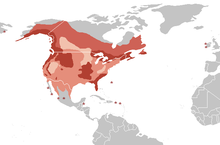
Back عقاب رخماء Arabic عقاب رخماء ARZ Haliaeetus leucocephalus AST Mikisiw ka wapictikwanetc ATJ Batakatakaf trimez (Haliaeetus leucocephalus) AVK Ağbaş qartal AZ Белагаловы арлан BE Белагаловы арол BE-X-OLD Белоглав орел Bulgarian বল্ড ঈগল Bengali/Bangla
| Bald eagle Temporal range: Pleistocene-Recent
| |
|---|---|

| |
| Bald eagle preparing to fly at Kachemak Bay in Alaska, United States | |
| A recording of a bald eagle at Yellowstone National Park | |
| Scientific classification | |
| Domain: | Eukaryota |
| Kingdom: | Animalia |
| Phylum: | Chordata |
| Class: | Aves |
| Order: | Accipitriformes |
| Family: | Accipitridae |
| Genus: | Haliaeetus |
| Species: | H. leucocephalus
|
| Binomial name | |
| Haliaeetus leucocephalus | |
| Subspecies | |
| |

| |
| Bald eagle range
Breeding resident
Breeding summer visitor
Winter visitor
On migration only
Star: accidental records | |
| Synonyms | |
Falco pygargus Daudin, 1800 (nec Linnaeus) Falco ossifragus Shaw, 1809 (nec Linnaeus)
| |
The bald eagle (Haliaeetus leucocephalus) is a bird of prey found in North America. A sea eagle, it has two known subspecies and forms a species pair with the white-tailed eagle (Haliaeetus albicilla), which occupies the same niche as the bald eagle in the Palearctic. Its range includes most of Canada and Alaska, all of the contiguous United States, and northern Mexico. It is found near large bodies of open water with an abundant food supply and old-growth trees for nesting.
The bald eagle is an opportunistic feeder which subsists mainly on fish, which it swoops down upon and snatches from the water with its talons. It builds the largest nest of any North American bird and the largest tree nests ever recorded for any animal species, up to 4 m (13 ft) deep, 2.5 m (8.2 ft) wide, and 1 metric ton (1.1 short tons) in weight. Sexual maturity is attained at the age of four to five years.
Bald eagles are not bald; the name derives from an older meaning of the word, "white headed". The adult is mainly brown with a white head and tail. The sexes are identical in plumage, but females are about 25 percent larger than males. The yellow beak is large and hooked. The plumage of the immature is brown.
The bald eagle is the national bird of the United States of America and appears on its seal. In the late 20th century it was on the brink of extirpation in the contiguous United States. Populations have since recovered, and the species's status was upgraded from "endangered" to "threatened" in 1995, and removed from the list altogether in 2007.
- ^ "Haliaeetus leucocephalus Linnaeus 1766 (bald eagle)". PBDB.
- ^ BirdLife International (2016). "Haliaeetus leucocephalus". IUCN Red List of Threatened Species. 2016: e.T22695144A93492523. doi:10.2305/IUCN.UK.2016-3.RLTS.T22695144A93492523.en. Retrieved November 19, 2021.
- ^ "Appendices | CITES". cites.org. Retrieved January 14, 2022.
